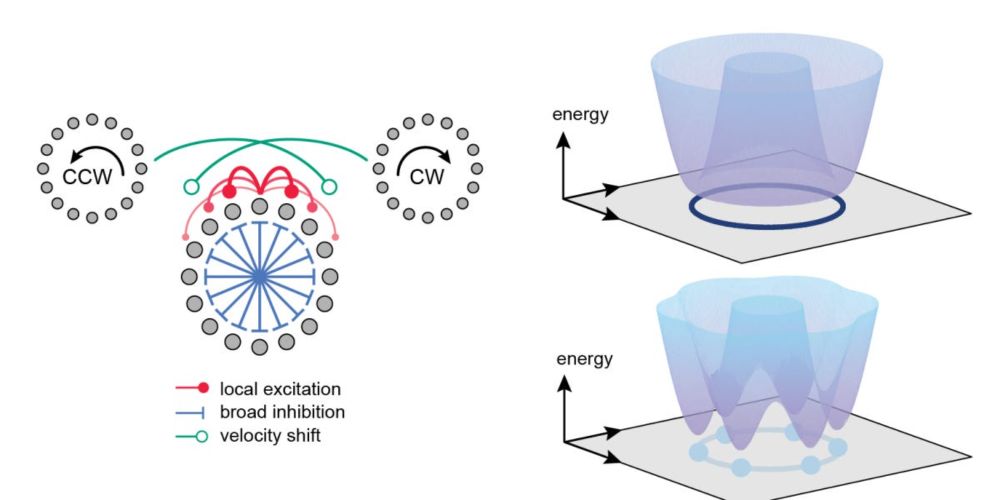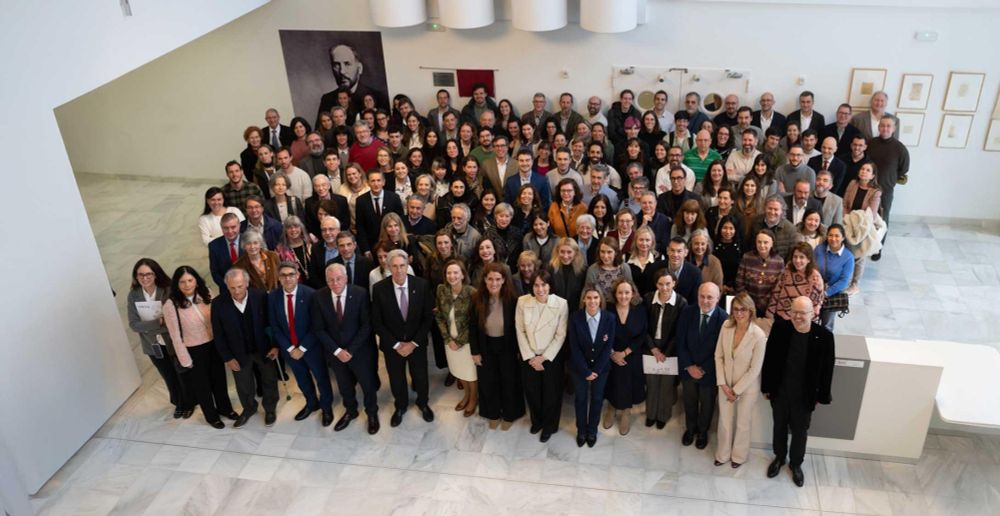P.S.: Feedback and thoughts are very welcome before the final publication. Specially if I forgot relevant work!
29.10.2025 12:58 — 👍 1 🔁 0 💬 0 📌 0
Altogether, our findings highlight how molecular-level heterogeneity contributes to macroscale brain function and state transitions, from wakefulness to sleep-like dynamics.
Thanks to co-authors Jan Fousek, Alain Destexhe and Mavi Sanchez-Vives. This work is a direct fruit from the HBP!
29.10.2025 12:58 — 👍 1 🔁 0 💬 1 📌 0
2) It boosts information flow across brain regions; and
3) Localized sleep-like slow waves can emerge within otherwise awake-like states — linking molecular and structural diversity to complex brain behavior.
29.10.2025 12:58 — 👍 1 🔁 0 💬 1 📌 0
In this study, we explore how regional variability in cholinergic receptor expression shapes large-scale brain dynamics. Using a biologically grounded whole-brain computational model, we show that:
1) Incorporating cholinergic heterogeneity enhances network synchronization;
29.10.2025 12:58 — 👍 1 🔁 0 💬 1 📌 0
I missed your above post 🤣
29.10.2025 12:29 — 👍 3 🔁 0 💬 0 📌 0

This metaphorical illustration reimagines a hidden view of the brain of a patient with hemispherotomy. In the absence of subcortical activating inputs, the disconnected cortex defaults to a sleep-like state, marked by slow-wave EEG activity and here evocatively represented as night. By contrast, the intact hemisphere, still integrated with subcortical structures, sustains wakefulness and a bright inner world capable of environmental interaction, reflected in faster EEG rhythms. The image underscores the divergence of cortical states after hemispheric isolation. The image was created by Michele A. Colombo, the first author of the paper, through digital photo manipulation combining drawings with real neuroimaging and electrophysiological data.
#Hemispherotomy is a surgical treatment for #epilepsy by disconnecting a portion of the #cortex. Michele Colombo, Jacopo Favaro, @anilseth.bsky.social, Marcello Massimini &co show that the isolated cortex has #EEG patterns resembling deep #sleep or #anesthesia @plosbiology.org 🧪 plos.io/3J9ci8X
17.10.2025 16:33 — 👍 12 🔁 6 💬 0 📌 0
Congrats!!!!
07.10.2025 10:36 — 👍 1 🔁 0 💬 0 📌 0
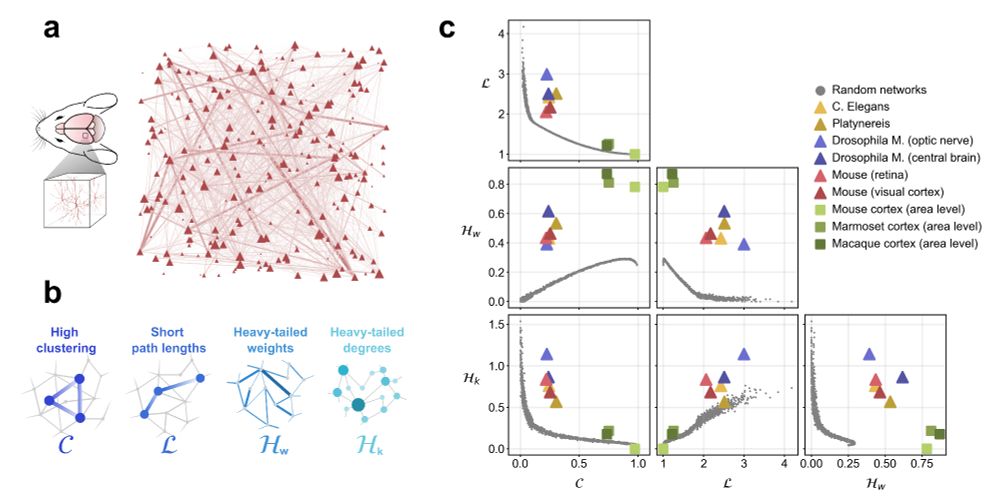
Brain networks from many animals have nonrandom structure. Including high clustering, short path lengths, heavy tailed weight distributions, and heavy-tailed degree distributions.
Are you at the @cnsorg.bsky.social conference?
Do you like networks? Brain-like networks? Pretty and structure rich networks? 🙇♂️🧠🕸
Come to my Poster 204 this afternoon (or anytime today)!!
The poster is right next to the coffee! ☕️ 😉
#CNS2025 #CNS2025Florence 🇮🇹🍝
07.07.2025 10:05 — 👍 17 🔁 5 💬 0 📌 0
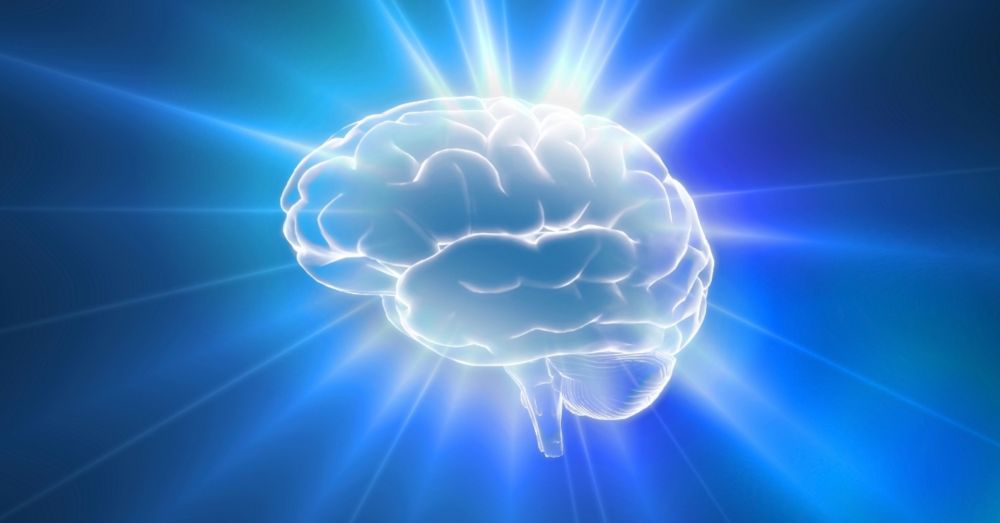
Doing This Might Actually Make You Smarter
You’re scrolling through TikTok with the sound off. Waiting in line for a coffee. Watching a guy try to parallel park for the third time...
Doing this might make you smarter ... (www.vice.com/en/article/d...) News coverage of our study on unsupervised learning in mice by @zhong-lin.bsky.social + @marius10p.bsky.social
#neuroscience #AI
www.nature.com/articles/s41...
02.07.2025 17:18 — 👍 9 🔁 3 💬 1 📌 0
Great news Dan. All the best!!!
24.06.2025 11:25 — 👍 1 🔁 0 💬 0 📌 0
I recently had the great pleasure of interviewing Michael Bruchas about an absolutely banger recent paper from his group that tracked down cells in the brainstem that subtlety and precisely control the output of the locus coeruleus. Check out my interview here. I hope you like it as much as I did!
08.05.2025 03:22 — 👍 47 🔁 16 💬 1 📌 1
I'd put these on the NeuroAI vision board:
@tyrellturing.bsky.social's Deep learning framework
www.nature.com/articles/s41...
@tonyzador.bsky.social's Next-gen AI through neuroAI
www.nature.com/articles/s41...
@adriendoerig.bsky.social's Neuroconnectionist framework
www.nature.com/articles/s41...
28.04.2025 23:15 — 👍 34 🔁 10 💬 2 📌 1

🧠🌡️ New preprint out!
BRAIN TEMPERATURE may be a key factor in understanding and treating Alzheimer’s disease and brain cancer:
doi.org/10.31219/osf...
'Temperature matters: Insights into brain thermoregulation and its impact on neural activity and health'
16.04.2025 06:33 — 👍 21 🔁 4 💬 1 📌 0

(B–D) Behavioral task for each species. Matching pennies task for monkeys (B), dynamic foraging task for rats (C), and visual discrimination task for mice (D). (E–G) Correlation between the timescales of neural activity and anatomical hierarchy score in monkeys (E), rats (F), and mice (G). Each dot and error bar, respectively, indicate the median and SE of the timescale within each area. In (F), black and pink dots represent data from the neocortex and hippocampus, respectively. Note that the data from the hippocampus (CA3, CA1, and SUB) do not have a precise hierarchy score. In (G), black and red dots represent data from the neocortex and thalamus, respectively. Blue, green, and yellow shading indicate the regions in the visual, somatomotor, and prefrontal areas, respectively. Dashed lines denote linear regression.
Despite species and task differences, timescales of these reward history signals (as well as intrinsic timescales) follow the same pattern of cortical hierarchy across different species.
www.pnas.org/doi/10.1073/...
06.04.2025 01:36 — 👍 30 🔁 7 💬 2 📌 2
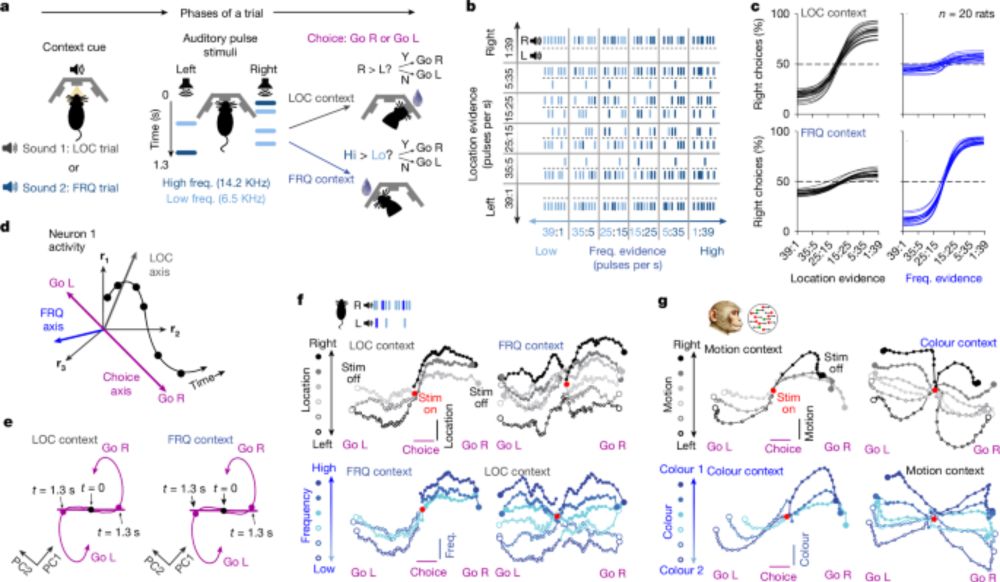
Individual variability of neural computations underlying flexible decisions - Nature
Behavioural experiments to study decision-making in response to context-dependent accumulation of evidence provide testable models that are consistent with the heterogeneity in neural signatures among...
1/7 Our paper on individual variability in decision-making is finally out in @nature.com! Inspired by the classic work by Mante and Sussillo, we trained many rats to solve context-dependent decision-making, and we found that different brains use different neural mechanisms to solve the same task!
21.03.2025 13:28 — 👍 237 🔁 86 💬 7 📌 5

Stable propagation of synchronous spiking in cortical neural networks - Nature
Nature - Stable propagation of synchronous spiking in cortical neural networks
Trajectories in state space are shown in Figures 3 & 4 of Stable propagation of synchronous spiking in cortical neural networks (Diesmann et al, Nature, 1999).
22.02.2025 06:59 — 👍 3 🔁 1 💬 1 📌 0
Translational Neuroscientist @ UK Dementia Research Institute & Imperial College London. Developing Temporal Interference stimulation (TI), Transcranial Focused Ultrasound (tFUS) and other novel neurostim tech. My passion is Parkinson's research.
Spatial+systems neuroscientist | Working out how the 🧠 generates 🌐 to find its 🧭 | Incoming Lecturer (Asst Prof) at the University of Manchester | Big fan of ancient things 🏺📜
AI x neuroscience.
🌊 www.rdgao.com
Neuroscientist, both computational and experimental. Also, parent of a teenager :) . All posts and opinions are in my personal capacity.
professional website: https://brodylab.org
PhD student in computational neuroscience @ UCL
🇹🇷🇨🇦
SIDB aims to discover the biological mechanisms underlying autism and neurodevelopmental conditions. Based at The University of Edinburgh, funded by the Simons Foundation Autism Research Initiative (SFARI).
https://linktr.ee/sidb_edinburgh
Professor Emeritus (University of Manchester), writes on biology, history of science & French Resistance. Biography of Francis Crick, out in Nov 2025.
Link to publications: https://orcid.org/0000-0002-8258-4913
Cofounder @noumenal-labs.bsky.social. Honorary Fellow at the UCL Queen Square Institute of Neurology. Free energy principle, active inference, Bayesian mechanics, artificial intelligence, phenomenology
Looking at protists with the eyes of a theoretical neuroscientist.
Looking at brains with the eyes of a protistologist.
(I also like axon initial segments)
Forthcoming book: The Brain, in Theory.
http://romainbrette.fr/
Postdoc researcher @ IUSS Pavia, #NEPLab | PhD in Cognitive Neuroscience & Philosophy of Mind | Into psycho/neurolinguistics, multimodality in semantic representations, non-literal language processing & mental imagery 🔍🧠🗣️
X: @federico_frau
Neuroscientist. Group Leader in the Brain Circuits and Behavior Lab at IDIBAPS, Barcelona.
Neuro-inspired Theory, Modeling, and Applications research group led by Mihai A. Petrovici @unibern.bsky.social
NeuroTMA website: https://physiologie.unibe.ch/~petrovici/group/
Centro de investigación en neurociencias del CSIC. Parte del Centro de Neurociencias Cajal.
Neuroscience research center assigned to the Spanish Research Council (CSIC).
Linktree: https://t.co/QbgpANoUkE
Web: cajal.csic.es
Correo: comunica@cajal.csic.es
Cuenta del Consejo Superior de Investigaciones Científicas, el mayor organismo público de investigación de España.
www.csic.es
RE at Instadeep, PhD in computational neuroscience, MSc in CS, interested in ML for life sciences.
Into brain development and evolution (+open science, generative art, genomics, music, 🇨🇱...). If you have questions about mechanical morphogenesis, I have more!
https://orcid.org/0000-0002-6671-858X







